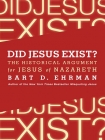Did Jesus Exist? - The Historical Argument for Jesus of Nazareth Bart Ehrman (books to read in your 20s txt) 📖

- Author: Bart Ehrman
Book online «Did Jesus Exist? - The Historical Argument for Jesus of Nazareth Bart Ehrman (books to read in your 20s txt) 📖». Author Bart Ehrman
Take as an example the way the story of Jesus is told in the early chapters of the Gospel of Matthew. It has long been recognized that Matthew wants to portray Jesus as a “new Moses,” and so it is no surprise to find that the things that happen to Jesus in Matthew closely parallel the Old Testament traditions about Moses. Just as the ruler of the land, the Egyptian pharaoh, sought to destroy Moses as an infant (Exodus 1), so too the ruler of the land, the Jewish king Herod, sought to kill the infant Jesus (Matthew 2). Jesus and his family escape by going to Egypt, the land of Moses. Just as Moses brought the children of Israel out of Egypt to come to the Promised Land (Exodus 13–14), so too Jesus returned from Egypt to Israel. Matthew emphasizes the point by quoting the prophet Hosea’s declaration of the salvation of Israel: “Out of Egypt have I called my son” (Hosea 11:1, quoted in Matthew 2:16), only now the “son” is not the nation of Israel but its messiah, Jesus. To escape Egypt, the Israelites had to cross the Red Sea at the exodus. The first thing that happened to the adult Jesus is that he too entered and then came out of the water at his baptism (Matthew 3). The Israelites were in the wilderness for forty years being tested by God, and so too Jesus went into the wilderness for forty days to be tempted (Matthew 4). The Israelites traveled to Mount Sinai, where they were given the Law of Moses; Jesus immediately went up to a mountain and delivered his Sermon on the Mount, where he provided an interpretation of the laws of Moses (Matthew 5–7).
In point after point, Matthew stresses the close parallels between the life of Jesus and the life of Moses. And his reason for doing so is clear: for Matthew, Jesus is the new Moses, who provides the authoritative interpretation of the Law of God to the people who choose to follow him. This portrayal is distinct to Matthew: the other Gospels do not include all of these parallels (no king sets out to kill the child; there is no flight to Egypt, no Sermon on the Mount, and so forth). It is the way Matthew personally shaped the story, for reasons of his own.
But the fact that Matthew shaped the story in this way has nothing to do with the question of whether or not Jesus existed. What the shape of the story makes us suspect are the many details, molded in such a way as to allow Matthew to make a theological point about Jesus (the new Moses). The historical existence of the object of the story is a completely different issue.
That is because stories are always shaped, not just by the biblical authors, but by everyone who tells them. And so we in the modern world shape the stories we tell in a number of typical ways. We have the rags-to-riches story, the feel-good war story, the downfall-of-the-great-man story. The shape of the story is not related to the question of whether the figure in the story actually existed.
It would be easy, for example, to tell the story of the demise of Richard Nixon in terms of Shakespearian tragedy. Many of the facts fit the mold well enough, and the facts that don’t fit can easily be bypassed or altered to make them fit. Does our ability to shape the story in the way we want mean that Watergate didn’t happen or that Richard Nixon never lived? No, it just means that Nixon’s story is amenable to a certain kind of shape.
So too with Jesus. Some of the followers of Jesus believed he was the new spokesperson of God, like Moses of old, and so they told stories about him to make the connections with Moses obvious. Many other followers considered him to be a prophet of God and the Son of God. And so they naturally talked about him in the ways they talked about other Hebrew prophets, such as Elijah and Elisha and Jeremiah.
A good example of how this works appears in the story of Jesus and the widow of Nain in Luke 7:11–17, which is similar in many ways to a story told about the prophet Elijah and his encounter with another widow, this one from Zarephath, also in the northern part of the land of Israel (1 Kings 17:17–24). Elijah learns that the only son of the widow has died, and he tells the mourning mother to give him the corpse. He raises the child from the dead and returns him to his mother, who proclaims, “Now that I know that you are a man of God and that the world of the LORD in your mouth is truth.” So too Jesus comes to Nain and learns that the only son of a widow has died. He tells her not to mourn, he goes up to the corpse, and he raises the young man from the dead. And the crowd’s reaction is similar: “A great prophet has risen among us and God has looked favorably on his people.” The crowd, in other words, realizes that Jesus has just performed a feat like his predecessor Elijah, and that he too, therefore, is a great prophet of God.
When a story about Jesus so closely parallels a passage in the Old Testament, it is reasonable to assume that the storyteller—in this case, Luke or his source—has shaped the story in light of its scriptural parallel. But is it fair to say, as Price does, that “the whole





Comments (0)